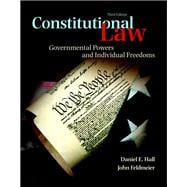For courses in constitutional law.
Introduces the core principles of constitutional law in relevant and readable style using real world scenarios and contemporary topics to bring the constitution alive for today’s student!
Relevant and readable, this Third Edition of Constitutional Law: Governmental Powers and Individual Freedoms remains the most up-to-date constitutional law textbook on the market. The text introduces readers to the core principles, cases, and doctrines surrounding the major issues of constitutional law, with an emphasis on governmental powers and civil liberties. Considering real-world cases and contemporary legal scenarios, along with ample visual aids, the text brings the constitution alive, making constitutional law seem relevant rather than remote and theoretical. Modern challenges, cases outside of the Supreme Court, and historical context are also considered, and the Third Edition has been updated with dozens of new cases and contemporary topics.








